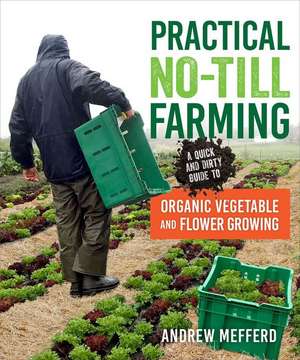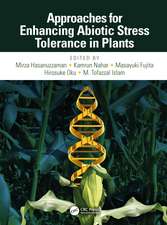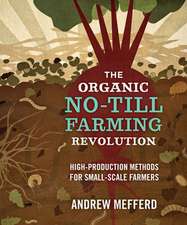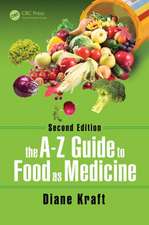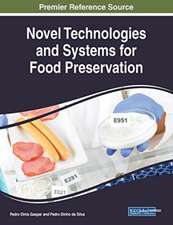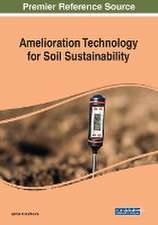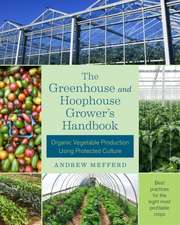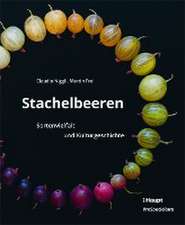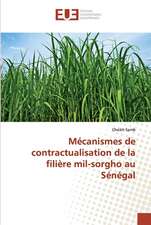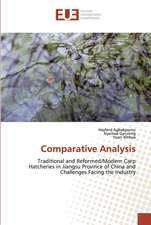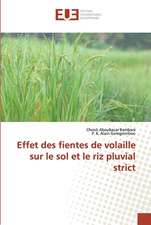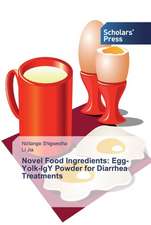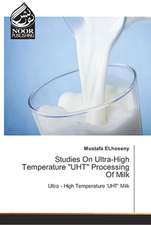Practical No-Till Farming
Autor Andrew Mefferden Limba Engleză Paperback – noi 2022
A no-nonsense breakdown of no-till market gardening that gets straight to the point and stays there. Practical No-Till Farming is arguably the most devourable technical manual I've come across. A great read and an even greater asset to organic flower and vegetable growers everywhere.
- JESSE FROST, author, The Living Soil Handbook
This is a book I wish I had when I was starting out. Helps clarify what the big deal is about no-till, how it's being defined, and how folks are actually making it work.
- JOSH VOLK, author, Build Your Own Farm Tools and Compact Farms
NO-TILL FARMING methods are taking small-scale farming by storm, promising less work, higher productivity, improved soil health, carbon sequestration, and weed control for organic growers.
There are many ways to approach no-till, including mulching with compost, cardboard, straw, silage tarps, and more-and there is no shortage of conflicting advice on how to get started.
Practical No-Till Farming is here to help, sorting the wheat from the chaff and the horse manure from the plastic mulch. Coverage includes:
- How to assess your farm for no-till options considering climate, soil, and crop selection
- Detailed descriptions of common no-till methods, including pros and cons, materials, and relative costs
- Choosing the most appropriate methods for your context
- How-to for each no-till method, including what to do and when
- Dealing with bindweed, symphylans, and other difficult weeds and pests
- Maximizing productivity of no-till beds
- Special coverage of both organic vegetable and flower no-till market farming.
If you're looking for a practical, down-to-earth book that explains both the whys and hows of no-till market gardening, this definitely is the book for you.
- JOHN IKERD, Professor Emeritus of Agricultural Economics, University of Missouri-Columbia
ANDREW MEFFERD is the editor of Growing for Market magazine and author of The Organic No-Till Farming Revolution and The Greenhouse and Hoophouse Grower's Handbook. He lives and farms in Cornville, Maine.
Preț: 182.00 lei
Nou
Puncte Express: 273
Preț estimativ în valută:
34.83€ • 35.98$ • 28.97£
34.83€ • 35.98$ • 28.97£
Carte disponibilă
Livrare economică 26 februarie-12 martie
Livrare express 12-18 februarie pentru 35.91 lei
Preluare comenzi: 021 569.72.76
Specificații
ISBN-13: 9780865719668
ISBN-10: 0865719667
Pagini: 240
Ilustrații: 100 Halftones, color
Dimensiuni: 188 x 226 x 15 mm
Greutate: 0.59 kg
Editura: New Society Publishers
ISBN-10: 0865719667
Pagini: 240
Ilustrații: 100 Halftones, color
Dimensiuni: 188 x 226 x 15 mm
Greutate: 0.59 kg
Editura: New Society Publishers
Cuprins
Part 1: The Why of No-Till
INTRODUCTION
Who This Book Is For
Tilling Was Once the Only Answer
Enthusiasm and Skepticism for No-Till
Becoming a No-Till Farmer
Defining No-Till: What Counts as Tillage Anyway?
New Adaptation for Old Methods
The Promise of No-Till
THE POWER OF THE SOIL
Putting a Face on the Soil
Soil: Where the Microbe Magic Happens
Taking Care of Our Livestock
Soil Life Drives the Success of No-Till Systems
Soil Testing
Healthy Soil Can Lead to Healthier Farmers
FARM SIZE
Farming as a Career
NO-TILL: A GATEWAY METHOD
Evolution of Your Farm
Small Can Be Beautiful
NO-TILL VS. TILLAGE
Tillage: The Agricultural Reset Button
Tillage: An Ancient Practice We Might Want to Avoid
THE DISADVANTAGES OF TILLING
Breakdown in the Nutrient Cycle
Weeds
Hard Work and Time-Consuming
Physical, Chemical, and Biological Disadvantages
THE ADVANTAGES OF NO-TILL
Advantages for the Environment
Fungus: The Perennial Roots of the Soil
Soil and Water Can Do Their Jobs
Increase in Organic Matter
Advantages for Growers
THE DISADVANTAGES OF NO-TILL
Fields Are Slower to Warm in Spring
Systems Can Take Some Time to Become Established
Some Methods Are Hard to Scale Up
Some Pests Can Flourish in High Residue
Perennial Weeds
Part 2: The How of No-Till
GETTING STARTED: PRINCIPLES, TECHNIQUES, AND TOOLS
Start with a Soil Test
Clearing the Deck: Getting the Soil Ready
Establishing New Fields
Sod Bustin', No-Till Style
Reduce the Weed Seed Bank First
TARPING
Occultation
Solarization
Tarp Timing
Decomposition Rates
IT'S ALL ABOUT THE MULCHES
Non-Decomposing Mulches
Applied Organic Mulches
MULCH GROWN IN PLACE
The Roller/Crimper Method
Roller/Crimper Cons
Winter-Killed Cover Mulch Crops
Planting through a Cover Crop Mulch
Which Crops Work Best in the Roller/Crimper System?
GETTING STARTED AND CROPPING STRATEGIES
Composting in Place
Compost as Mulch
Ways to Improve Land and Exhaust the Weed Seed Bank
CROPS TO FOCUS ON
GOING FROM CROP TO CROP
Dealing with Residue
Planting
Flowers in No-Till
CASE STUDY: GROWING HEMP
APPENDIX
NOTES
BIBLIOGRAPHY
INDEX
ABOUT THE AUTHOR
ABOUT THE PUBLISHER
INTRODUCTION
Who This Book Is For
Tilling Was Once the Only Answer
Enthusiasm and Skepticism for No-Till
Becoming a No-Till Farmer
Defining No-Till: What Counts as Tillage Anyway?
New Adaptation for Old Methods
The Promise of No-Till
THE POWER OF THE SOIL
Putting a Face on the Soil
Soil: Where the Microbe Magic Happens
Taking Care of Our Livestock
Soil Life Drives the Success of No-Till Systems
Soil Testing
Healthy Soil Can Lead to Healthier Farmers
FARM SIZE
Farming as a Career
NO-TILL: A GATEWAY METHOD
Evolution of Your Farm
Small Can Be Beautiful
NO-TILL VS. TILLAGE
Tillage: The Agricultural Reset Button
Tillage: An Ancient Practice We Might Want to Avoid
THE DISADVANTAGES OF TILLING
Breakdown in the Nutrient Cycle
Weeds
Hard Work and Time-Consuming
Physical, Chemical, and Biological Disadvantages
THE ADVANTAGES OF NO-TILL
Advantages for the Environment
Fungus: The Perennial Roots of the Soil
Soil and Water Can Do Their Jobs
Increase in Organic Matter
Advantages for Growers
THE DISADVANTAGES OF NO-TILL
Fields Are Slower to Warm in Spring
Systems Can Take Some Time to Become Established
Some Methods Are Hard to Scale Up
Some Pests Can Flourish in High Residue
Perennial Weeds
Part 2: The How of No-Till
GETTING STARTED: PRINCIPLES, TECHNIQUES, AND TOOLS
Start with a Soil Test
Clearing the Deck: Getting the Soil Ready
Establishing New Fields
Sod Bustin', No-Till Style
Reduce the Weed Seed Bank First
TARPING
Occultation
Solarization
Tarp Timing
Decomposition Rates
IT'S ALL ABOUT THE MULCHES
Non-Decomposing Mulches
Applied Organic Mulches
MULCH GROWN IN PLACE
The Roller/Crimper Method
Roller/Crimper Cons
Winter-Killed Cover Mulch Crops
Planting through a Cover Crop Mulch
Which Crops Work Best in the Roller/Crimper System?
GETTING STARTED AND CROPPING STRATEGIES
Composting in Place
Compost as Mulch
Ways to Improve Land and Exhaust the Weed Seed Bank
CROPS TO FOCUS ON
GOING FROM CROP TO CROP
Dealing with Residue
Planting
Flowers in No-Till
CASE STUDY: GROWING HEMP
APPENDIX
NOTES
BIBLIOGRAPHY
INDEX
ABOUT THE AUTHOR
ABOUT THE PUBLISHER
